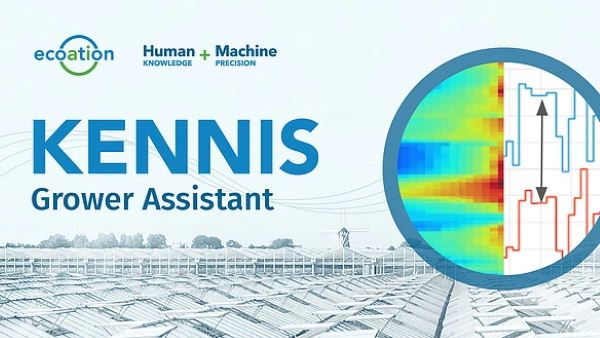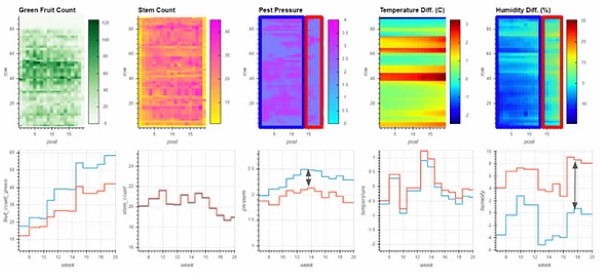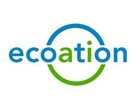With an official launch date of November 15, 2020, Ecoation introduces the newly patented KENNIS Grower Assistant. KENNIS combines the vast amount of data collected by OKO products and utilizes machine learning and AI / IA technology to provide an accurate stereo spatio temporal understanding of not only what is happening at every cubic meter of the greenhouse, but why it is happening while offering suggestions on what to do next.

Ecoation’s OKO product line offers various sensory packages (Digital, Immersive and Proactive) with stackable features and capabilities, including IPM, crop work monitoring, yield assessment, climate measurement, crop registration, etc. This flexibility enables each customer to build a product bundle that matches the needs of their operation. The KENNIS Grower Assistant is the next step. KENNIS builds on the OKO robotic platform and sensory packages by incorporating machine learning, next-gen Artificial Intelligence (AI) and Intelligence Augmentation (IA) to understand data stereo spatio temporally and provide actionable insights and intelligence to empower and extend a grower’s expertise beyond time, geography, and current possibilities. Referencing the Dutch term for knowledge and cognition, KENNIS exists to give growers the tools they need to turn observational data into decision-making power and know-how.
“We’re creating new information by sending sensors everywhere, and then boiling it down into actionable intelligence,” explains SVP of Data Science, Dr. Greg Stewart. “We’re not looking to replace the human component, but rather to support, augment, and extend what they are able to see and provide insights to better inform their decisions.”
KENNIS provides a different diagnostic understanding depending on the OKO package in operation. For example, OKO Digital creates a two-way communication pathway between the individual on the ground and the grower’s office, so that observations can be communicated in near real-time and tasks can be assigned immediately. Incorporating KENNIS into OKO Digital will build on human observation and allow the grower to use the revolutionary AI / IA algorithm to reduce the seemingly endless data supply into a shortlist of potential root causes and suggested action. Similarly, combining KENNIS with the OKO Immersive and/or Proactive packages would incorporate information about the greenhouse environment climate and changes across different heights of the canopy, 360-degree visual inspection results, and/or plant health.
While the award-winning OKO product line boasts capabilities to observe, record, and report information, KENNIS uses this data provided by the OKO to create insights about the why. These insights will allow the grower to not only observe an area of low production reflected in an abnormality in the sensory data but also understand why this is happening using the generated shortlist of the issues and potential causal variables. In practice, this might resemble a situation as depicted in the illustration below. The red rectangle brings the grower’s attention to an area near the greenhouse wall which is more humid than the rest of the greenhouse (blue rectangle) in the 5th plot. Additionally, pest pressure, in this case Russet Mites, is also much higher in the dry area (blue rectangle) as illustrated by the difference between the red and blue time trends in the middle plot. Given that there is no significant corresponding variability in stem density or temperature, KENNIS has discovered a relationship between humidity and pest pressure and indicates the areas of the greenhouse that are affected. Given this insight, a grower could choose to augment their IPM program by adjusting their climate parameters and physical infrastructure (e.g. individual fan speeds or overhead misters) to maintain a higher humidity in regions that have consistently low humidity, thus creating a less favorable environment for this pest, and decreasing the dependence on treatments to control the pest. The grower might also be interested to investigate the difference in the number of green tomatoes between the two regions. Many IPM programs are based on prophylactic and “standard” solutions. KENNIS allows growers to test and confirm if the standard approach is best or if adjusting their strategy will maximize success and minimize cost.

Russet Mite Case: Illustrated Example
“Having a diagnostic tool that allows us to have a deeper look at what is going on in the greenhouse and why certain things are happening is basically going to change everything,” remarked Founder and CEO, Dr. Saber Miresmailli. “This means that [growers] will have the ultimate visibility into their operations and the causal effects that create the situations they have to resolve. Another group who can vastly benefit from this invention are seed companies who can fast track experimentations and confirm their desirable traits under various conditions with KENNIS and find what does it take for a particular gene to express.”
For more information: Ecoation
Ecoation
Sales Director, Albert Pinto
[email protected]
www.ecoation.com
